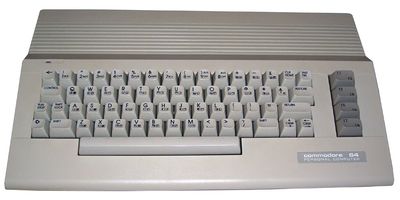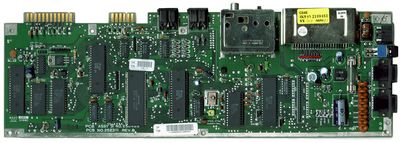C64C
| C64C | |
 | |
| Type: | Home Computer |
| Producer: | Commodore |
| Price: | under 600 US$ |
| Released: | 1986 |
| Discontinued: | 1993 |
| Processor: | MOS 6510/8500 @ ca. 1 MHz |
| Memory: | 64 KByte, upgradeable |
| OS: | BASIC V2.0 |
| Info: | - alias C-64 C or C64 II, different spellings |
The Commodore 64C (or C64C for short) is a redesign of the successful Commodore 64. Due to the light color scheme and the slim case, it can be easily distinguished from the original C64 ("Breadbox"). The official name was C64C, although in Germany the magazine 64'er used the name C64 II, which continues to be used among German enthusiasts. There are no major hardware differences between the C64C and the original C64, and the units are largely identical in terms of graphics, sound, processor speed, interfaces and RAM size.
Design[edit | edit source]
The C64C (aka C64-II) was the first C64 which featured a redesigned outer case, molded in a light beige color and made to resemble the C128, both in terms of design and color scheme. Because it reuses the same keyboard as the original C64 (albeit with recolored keycaps to match the new case), it does not have a numeric keypad like the C128.
During the C64C's production, Commodore made subtle changes to the case design in order to reduce production costs. Some later C64Cs are held together solely with plastic clips (instead of three screws at the front and clips on the sides and rear) and very late C64Cs also have the "Commodore 64" badge on the lower right molded into the plastic.
Printed Circuit Board[edit | edit source]

The C64C went through several board revisions during its production. The most notable ones are listed below:
- In 1986 and 1987, the C64B and C64B3 boards were used. The PETSCII graphic symbols on the keyboard are printed on the front of the keys as with the original C64.
- From mid-1987 on, only the smaller C64E board was used. These models featured a keyboard with revised keycaps with a different font and the PETSCII symbols printed on the top. Because of this, it is possible to identify which board is inside the computer without needing to open it up.
The C64E board revision is notable in that it consolidated a number of IC chips and featured a revised VIC-II. Perhaps one of the most notable changes was the introduction of the 8580 SID chip, which uses a lower voltage (9V DC compared to 12V DC on the 6581) on its secondary voltage rail and a revised filter, giving it a different sound compared to the original 6581 SID.
In terms of chip consolidation, the C64E board features the following changes:
- The RAM is now made up of two 41464 chips as opposed to eight chips on older revisions.
- The two 8 KB ROM chips for BASIC and the kernal have been combined into a single 16 KB ROM chip (251913-01).
- The PLA and some TTL chips have been integrated into a 64-pin ASIC (251715-01 or 252535-01). The "252535-01" revision also contains the color RAM.
Through these changes, production costs could be further reduced and the C64C could be offered for a lower price than the original system.
Compatibility[edit | edit source]
The C64C was 100% software compatible with the original. Due to the slimmer case, some internal expansions (e.g. floppy speeder) could no longer physically fit inside the computer. A few external accessories made to fit the original C64 would also not fit the C64C. Since the 8580 SID uses a different filter, most sound "samples" are almost inaudible or are very quiet. However, this can be mostly remedied by a small hardware modification.
Miscellaneous[edit | edit source]
With some C64Cs, an early version of the new graphical operating system GEOS (Version 1.2 or 1.3) was bundled with the computer. Commodore also introduced a restyled 1541 disk drive known as the 1541C, which used the same color scheme as the C64C. In 1988, Commodore introduced the 1541-II, which was a complete redesign of the 1541 intended to more closely match the C64C.